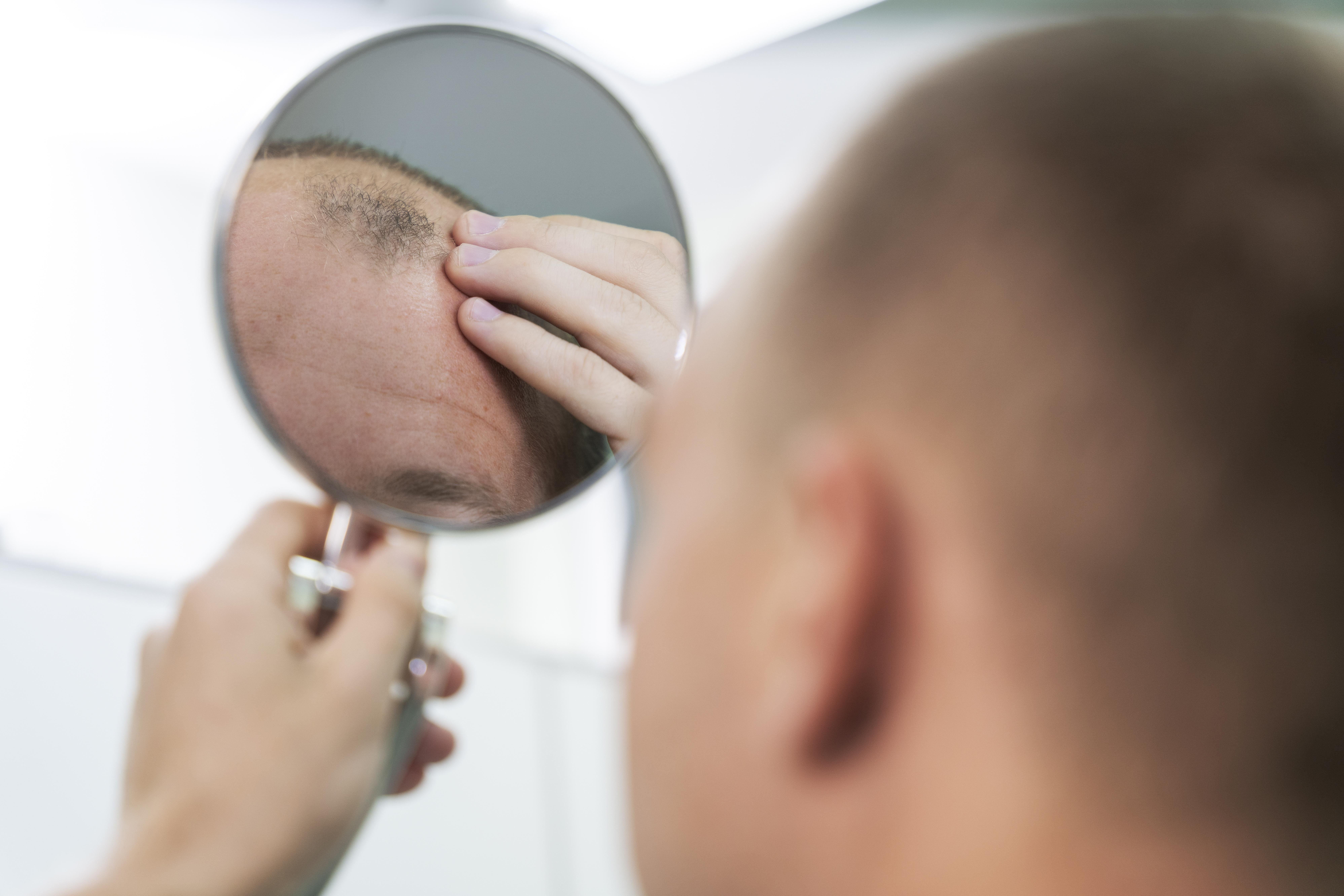Last Updated on: 30th May 2023, 05:04 pm
What is Male Pattern Hair Loss or Baldness?

Male pattern baldness (MPB) occurs when there is significant hair loss on the scalp.
It usually begins in the front of the head as the hairline recedes to the top than the back of the scalp.
This type of hair loss is also called androgenetic alopecia areata which occurs due to the change in hormone levels in the body.
What are other causes of male pattern baldness?
1) Genetics
Male hair loss that is caused by genetics can be seen in the earlier stages where hair loss progresses as the person reaches their mid-twenties.
In peer-reviewed studies, individuals who experience hair loss due to genetics or family history have sparse hair due to male sex androgens or Dihydrotestosterone (DHT).
When DHT builds up in the hair follicles over time, it shrinks the hair follicle’s growth phase.
Taking DHT blockers, which is a prescription drug, have been known to stimulate hair growth if taken in the early stages of hair loss.
2) Lifestyle
Male pattern baldness symptoms such as a receding hairline, slight recession in the hairline, balding areas or a bald spot can be caused by the following issues:
- smoking
- stress
- thyroid imbalances
- nutritional deficiencies
- alcohol
Iron deficiency, emotional and physical stress can also impact healthy hair follicles as stress signals are sent to the hair follicles, causing them to enter a resting phase due to the large levels of adrenaline that the body releases.
What are the seven stages Of Male Pattern Baldness?
The Hamilton Norwood scale can help understand how severe your hair loss is and help you uncover what hair loss treatments you can use to regrow hair.
It categorizes the stages of male pattern baldness depending on hair loss and a receding hairline that makes men’s foreheads more prominent.
The seven different stages to gauge the severity of your balding.
The stages are:
Stage 1: Unnoticeable hair thinning
At this stage, hair loss is minimal and the head remains covered with hair.
A person begins to lose hair around the temples and forehead and new hair does not grow back.
How to treat stage 1 of male pattern baldness?
It is rather difficult to identify if this is just temporary hair loss or the start of male pattern baldness, therefore a great solution will be to look at you family history to uncover any history of balding.
If hair loss is indeed genetic, then it is important to head over to a healthcare professional to get treatment options to stop further hair loss or slow hair loss.
Topical minoxidil can also be used to to promote new hair growth.
There are also natural treatment options to try such as oiling the hair with coconut oil to strengthen the hair follicle.
Stage 2: Hair thinning and an M-shaped hairline
The Norwood scale at stage 2 can be identified when hair at the temples and the forehead begins to thin more and more to reveal a much more mature hairline.
This could also be termed as front baldness or thinning at the crown among males which are early signs of balding.
Though this is still mostly unnoticeable, the hair loss around the forehead creates an M-shaped hairline.
How to treat stage 2 of male pattern baldness?
Hair loss treatments will differ depending on whether it is genetics or lifestyle.
If your balding is genetic, significant hair loss can be delayed with medical procedures or holistic ones.
However, if it is caused by your lifestyle, then it is important to change it to stop hair loss permanently.
Stage 3: Visible balding and recession of hairline (maybe M, U or V shape)
Balding becomes more evident at this stage as the hairline recedes deeper and widens at the forehead to form an ‘M,’ ‘U’ or ‘V’ shape.
Hair at the top of the scalp becomes thinner and bald spots are seen in this stage of male pattern baldness.
How to treat stage 3 of male pattern baldness?
One of the treatment options at this stage is to consume DHT blockers to postpone balding by reducing DHT levels in the body.
Consuming DHT-blocking foods that are high in zinc can also help to slow down DHT production in the body.
Zinc contains a compound called phytosterol that blocks excess DHT production in the body.
Using a derma roller for your hair & oiling after its use is also extremely beneficial.
A clean derma roller is a hair treatment that controls hair loss and regrows your lost hair.
You could also switch up your hairstyle to hide that receding hairline.
Stage 4: Extensive hair loss at the back of the head
At this stage of male pattern baldness, you will easily identify bald spots and scalp expansion happens rapidly, creating a bald patch due to the hair on the crown that is thinning, and large patches of hair being lost at the back of the head.
How to treat stage 4 of male pattern baldness?
Since you have already lost a large portion of your hair, a visible and impactful solution may be complicated.
Male pattern baldness at this stage requires a visit to the doctors along with major lifestyle changes focuses on reducing the DHT levels in the body.
Reducing cigarette smoking (if you cannot quit altogether), along with having an agile and active lifestyle in exercising, or choosing simple ways to keep your body in motion are easy ways to reduce DHTin the body naturally.
Stage 5: Horseshoe/U-shaped hairline at the crown
According to Norwood scale, this stage in male pattern baldness forms a U shape on the hairline.
This means that the hairline has receded significantly and it is much more challenging to treat.
How to treat stage 5 of male pattern baldness?
Other than consuming DHT blockers, this is the stage where surgical procedures such as hair transplantation is required.
Hair transplants works by taking hair from thicker parts of your scalp or other parts of your body.
This hair is then grafted to the thinning or balding section of the scalp.
Scalp micro pigmentation is another procedure that works by depositing pigment into parts of your scalp with limited hair growth.
It creates an appearance of tiny hair follicles that help thicken and restore the look of fuller hair.
Stage 6: Visible scalp and larger bald patches
In Stage 6 of the Norwood Hamilton Scale for male pattern baldness, suggests that hair loss happens at the sides of the head.
By this stage of male pattern hair loss, one has large bald patches or a permanent bald spot.
How to treat stage 6 of male pattern baldness?
While micro-pigmentation and hair transplants are an option, you can also opt for a scalp reduction procedure.
This procedure reduces regions on your scalp with no hair and brings the hair growth areas together.
Therefore, it can reduce the baldness on the head.
This procedure can be clubbed with a hair transplant to give you a fuller-looking scalp.
Stage 7: Recession to the crown with minimal thin hair
If you have reached stage 7 of the Norwood Hamilton Scale, your hairline has receded to the crown, and the very little hair remaining on the sides is too thin.
How to treat stage 7 of male pattern baldness?
There are no treatment options left to be done at this stage.
The best way to deal with this is to embrace a natural look by shaving off the hair completely or by wearing a wig.
There are plenty of wigs in the market that appear natural and some even look better than a hair transplant.






